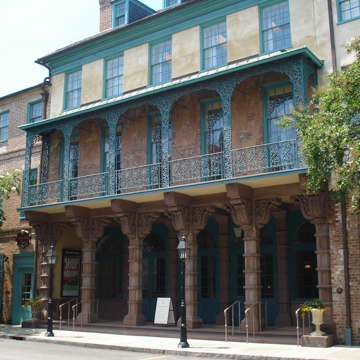You are here
Dock Street Theatre
Only fragments remain of the brick structure that was possibly the second in America built specifically for theatrical performances. Raised in 1736 and rebuilt in 1754 after it was destroyed by fire, by the end of the eighteenth century the theater closed and became derelict. In 1809, Alexander Calder (ancestor of the twentieth-century sculptor of the same name) purchased the former theater building and adjoining properties and fashioned them into the Planter’s Hotel. This, Charleston’s first major reported hotel, was situated at Church and Queen streets in the very heart of the city. Renovations and improvements in 1835 revealed Calder’s efforts to attract and accommodate wealthy guests. These improvements included the addition of an ornate Italianate loggia supported by banded brownstone columns topped with carved wooden brackets that, in turn, support an elaborate cast-iron balcony.
In 1935, funds from the Works Progress Administration (WPA) supported rehabilitation of the building and creation of a new theater. Albert Simons, a local architect then gaining a reputation as a leader in Charleston’s early historic preservation movement, headed the effort to recreate an eighteenth-century theater inside the shell of the Planter’s Hotel. Inside the former hotel’s entrance loggia, Simons’s placed a large lobby and monumental stairs leading to the balcony level. At the same time Simons was working on the hotel’s conversion, he was overseeing the demolition of the late-eighteenth-century Radcliffe-King House on Meeting Street and he installed elements of its neoclassical interior, including sections of its cornices, mantels, and door and window architraves, in the new theater’s public rooms. The design of the new theater included the coat-of-arms of George II hung at the apex of the proscenium arch, thus providing a symbolic visual link between the original theater and its modern recreation.
Managed by the city of Charleston, Dock Street Theatre hosts theatrical and musical performances throughout the year, including the popular Chamber Music series presented annually during the Spoleto Festival USA.
References
Bull, Elias B., “Dock Street Theater,” Charleston County, South Carolina. National Register Inventory-Nomination Form, 1973. National Park Service, U.S. Department of the Interior, Washington, D.C.
“Charleston Opens Historic Playhouse with Historic Play.” Architectural Record83, no. 1 (January 1938): 20-25.
Heyward, Du Bose. “Dock Street Theatre.” Magazine of Art31, no. 1 (January 1938): 10-15.
Poston, Jonathan H. The Buildings of Charleston: A Guide to the City’s Architecture. Columbia: University of South Carolina Press, 1997.
National Park Service. “Dock Street Theatre.” U.S. Department of the Interior. Accessed September 1, 2015. www.nps.gov.
Writing Credits
If SAH Archipedia has been useful to you, please consider supporting it.
SAH Archipedia tells the story of the United States through its buildings, landscapes, and cities. This freely available resource empowers the public with authoritative knowledge that deepens their understanding and appreciation of the built environment. But the Society of Architectural Historians, which created SAH Archipedia with University of Virginia Press, needs your support to maintain the high-caliber research, writing, photography, cartography, editing, design, and programming that make SAH Archipedia a trusted online resource available to all who value the history of place, heritage tourism, and learning.














